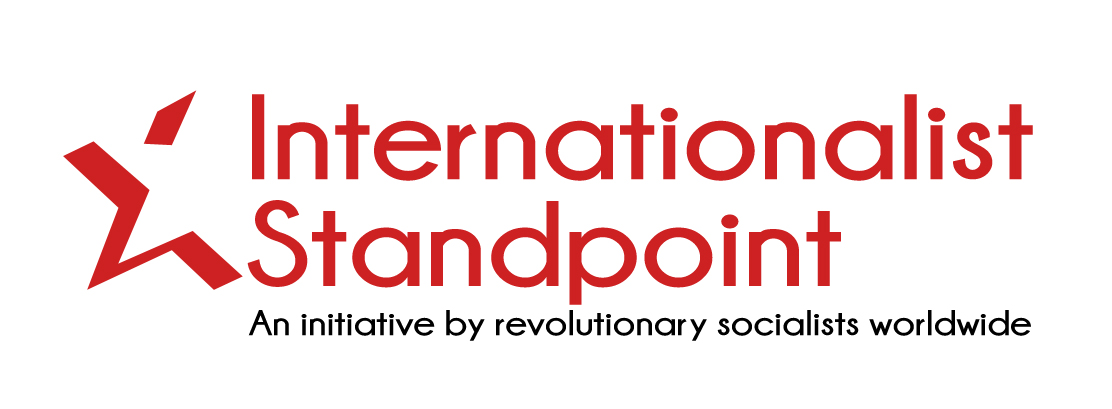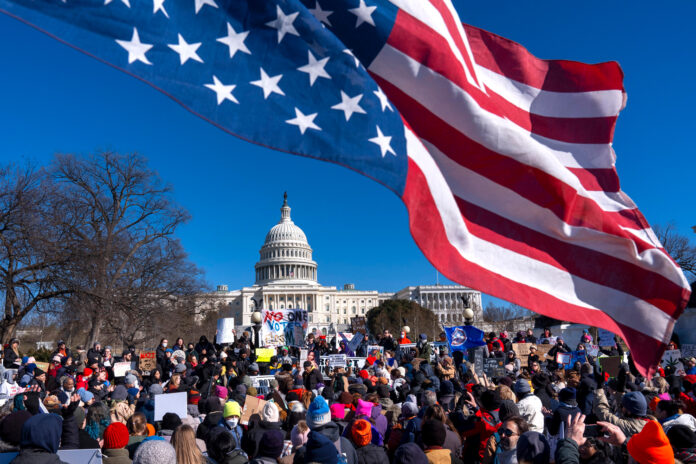by Nick Wozniak, Chicago
When announcing the new US – UK trade agreement, President Donald Trump commented that the deal was only possible because he “blew up the whole international trade system.”
Trump’s turn of phrase captures his ferocious assault on the status quo. Trump has returned more experienced and better prepared by a more solid MAGA movement to carry out a reactionary, nationalist, authoritarian and pro rich agenda. Trump has been gleeful about the freedom he feels to break taboos and attack all those that oppose him. He promises his destruction will clear the way for “deal making” and “a new golden age for America.”
Yet after months of seemingly smashing through norms and opposition, Trump’s shock and awe is quieting. The brazen, Musk/DOGE style of “move fast and break things” has stalled. While the Democrats have failed to show any real fight, Trump is nonetheless running up against certain realities and has overreached politically. The situation is shifting to a different stage.
The Logic Behind the “Mad King”
Trump now faces the obvious challenge of what is to replace the old system that he “blew up.” Affecting a new direction for US capitalism means coming up with serious and consistent plans. And notoriously, Trump and those around him can be incoherent, incompetent, short sighted, factional, and corrupt. Yet, however much the narrative of Trump as a “mad king” captures the experience of the news cycle, it can muddle more than clarify.
In truth, Trump does have a coherent set of general goals. They are a response to the deep crisis faced by US capitalism, its most protracted in the 80 years since the US ruling class became the most powerful on the planet.
Seventeen years on from the 2008 crash, neither US party has been able to banish the Great Recession’s legacy of economic stagnation and the collapse in popular legitimacy of almost every major critical institution of capitalism and the state.
It is better to see Trump as a useful battering ram for a broad US ruling class consensus to confront this impasse. There are many continuities that go back even to the late Obama years. Its key planks include:
(i) reorganize globalized world trade around weakening China and (some) US reindustrialization;
(ii) preserve the US as the dominant economy and the dollar as the world reserve currency; and
(iii) push US allies to pay up and pull their weight as a part of a world capitalism system dominated by US imperialism.
Trump’s Momentum Slows, But More MAGA Attacks Are On The Way
Even within the parameters of the program listed above, there is of course very intense conflict, debate, and confusion within the ruling class itself regarding the precise way forward and particular policies. Trump’s agenda is now encountering the friction and polarization that plagues US elites.
Debates that have swirled on the MAGA right for years are sharpening, and overlapping with issues raised by major sections of big business on Wall Street and in Silicon Valley. There are fights for Trump’s ear, who is himself playing a more central role in setting crucial policies this time around. This can be seen in regards to Ukraine/Gaza/Iran “peace making”, the “big beautiful bill” in Congress, and on his tariff/ trade policies. A notable example of this growing discord: a Trump aligned group is challenging his tariff setting powers in court.
The chaos of MAGA leads to ramshackle follow through and persistent policy contractions. Trump’s administrators are often flying blind. Elon Musk’s much hyped DOGE wrecked enormous havoc but is seen as an inefficient, counterproductive failure inside the administration.
Adding to Trump’s challenges, direct opposition is also beginning to have more of an effect. Although aligned with the Democratic Party (dismally weak in its Congressional opposition), the US has seen the biggest days of protest since 2020.
Sections of the elites under pressure or attack by Trump are starting to resist and push back. Harvard, of all places, has set an example by refusing to submit to Trump’s aggressive intervention (initiated by mistake apparently).
Court rulings have been most impactful so far in actually halting Trump’s unprecedented onslaught of executive orders. Judges have ordered the rehiring of workers fired by DOGE, cuts rescinded, agencies reopened, immigrants returned, and protest leaders released by ICE. The administration has been complying with courts.
Yet Trump’s defiant rhetoric targeting judges, use of steam rolling “unitary executive” legal theories, and effective disobedience in some outstanding reversals, like the Kilmar Abrego Garcia deportation, has aggravated even right wing, Trump appointed judges. The Republican dominated Supreme Court will seek to compromise with Trump by awarding him new powers. But Trump’s aggressive pressure has already led them to rule against him and bigger showdowns between the two are coming down the road.
Trump has done enormous damage and his agenda has by no means hit a wall. He intends to pass congressional legislation by this summer that will turbocharge deportation enforcement, unleash a new wave of corporate deregulation, give tax cuts to the rich, kick millions off Medicaid low income health coverage, attack trans health care, and cut food assistance.
He will also continue forward on his two most path-breaking initiatives; the global trade war and his authoritarian efforts to wield a new level of concentrated executive power.
Trump Bets Big on Global Trade War
The trade war aims to recircuit trade and force open space for “deals” for private or foreign investment to fund the renovation of US capitalism. Trump’s vision was on full display in his visit to the Gulf, where over $3 trillion was promised (skepticism of actual delivery is warranted).
Manufacturing is to return to the United States. Trump is scatter brained on what sectors he is targeting for revival, but they are certainly not the clean energy technologies that Biden sought to kick start. Trump’s industrial plans are powered by cheap and expanding US fossil fuel production.
The strength of Trump’s approach is that he is putting the weight of US economic and imperial might on the scale in an unprecedented way. The US remains uniquely economically and militarily powerful, even in the face of a rising China. Trump intends to make full use of this, with mafia style threats and reckless audacity. This was on display at the April 2nd “Liberation Day” tariff announcement, which shocked staff in the administration and triggered a stock market panic.
The situation has since calmed, mainly because Trump has made a series of retreats in the form of 90 day pauses and other carve outs. Business elites hope former Democratic donor and hedge fund manager Treasury Secretary Scott Bessent can steer Trump toward deals that will bring tariffs down. Bessent made good on Wall Street’s trust by securing the most important retreat: a step down from embargo level rates between China and the US.
Nevertheless, Trump’s messy tariff rollout has raised high stakes for the deals he has promised. Although the stock market has recovered, investors are still wary of US Treasuries. Reportedly this outcome was not anticipated in the administration. Treasuries are typically a safe place for the wealthy to put their money in turbulent times. The fact that Treasury safety has wobbled indicates global capitalists have low confidence in Trump’s direction.
There is more blowback on the way. Higher inflation and lowered growth if not recession are anticipated, although estimates struggle to to keep up with events. Trump’s “dozens of deals” have not so far materialized.
Trade War Trends
Trump’s only deal, with the UK, did not contain many concrete items or huge economic potential for the US. However, it does foreshadow a few trends:
- A base line tariff of 10% on goods; this is a high rate compared to the past decades and is a crude tool rather than a targeted one.
- Deals will likely consist of some concrete agreements and the lowering of some tariffs, alongside vague commitments to discuss many things in the future. In other words the “deal making” process will extend far past Trump’s negotiation window.
- Trump is pursuing commitments to collaborate to limit some Chinese industries and trade.
These trends could result in a quagmire of negotiations and up and down tariffs that could run the entirety of Trump’s term. China has protested the UK-US trade deal, and efforts to isolate its huge economy and impressive technology advancements will be limited at best.
However, a shared interest in restraining Chinese power could provide the framework to bring together more coherent deals over the longer term with Europe, Japan, and some other major countries like India. Trump undermines this prospect by making his threats and attempting to abandon US security guarantees. A chaotic, and not yet determined, diplomacy is underway with a number of countries, most prominently Europe – Ukraine – Russia, that could settle security issues and trade deals alongside each other.
In spite of nationalist and “pro worker” counter trends within MAGA, Trump’s search for trade deals and foreign investment so far points to a harder form of neoliberalism, marketed with the glorification and fantasy of individual enrichment.
At base Trump is attempting to export the crisis of US capitalism abroad. A halfway effective policy to do so will have the support of US mega corporations. Although it’s not possible to identify the balance of success and failures at this stage, the left must be prepared to confront the strength that could develop behind this project.
The Popular Backlash to Trump Overreach Has Arrived
Trump is urging that the country have patience for his policies. He talks of short term sacrifice now, followed by long term gain. And so far he is solidly retaining his historic base of support, who has seen Trump’s overall whirlwind of dramatic action as a sign that he is following through. His MAGA base will give Trump’s policies time and will be open to redirecting anger over failures at scapegoats.
But fundamentally Trump has disregarded the fact that, to get elected, he required another layer who selected him as a lesser evil, anti-inflation candidate. Trump’s huge gamble on the trade war has upended the economic confidence in him so important to his 2024 victory. He has overreached and lost his wider support, with poll numbers dropping the fastest in the modern era.
Many 2024 Trump voters did not like him, nor many of his policies. By driving a hard right agenda on all fronts Trump pleases the MAGA base, but alienates a majority of the country. On issue after issue that were strengths for Trump, such as immigration, Ukraine, inflation, the economy, he is now underwater in polling.
All of this is before the expected fallout from the trade war really hits. Lost markets and inflation will come to impact even the outlook of the small-time capitalists, farmers, and struggling workers in Trump’s base.
Political stability in the US antiquated and undemocratic electoral system requires supermajority support for a single party or bloc. Trump’s MAGA base is the largest and most solid in the country at the moment, but still a minority below 40%. Any hope of consolidating the wider gains of 2024 over the long term now hinge Trump’s trade war and other economic policies actually paying off.
No president has recovered from the lows in support that Trump now holds. It helps him that the opposition Democratic party is also enormously unpopular and in disarray over the implosion of the Biden presidency. But this does not mean the Democrats cannot be revived electorally. In the 2026 midterms they will benefit from a lower turnout election that skews towards their wealthier and more highly educated supporters.
Trump no doubt wants to enjoy genuine majority support. But his centralization of power into the executive branch is intended to function as a counterweight if needed, to negate the limitations of his unpopularity and narrow Republican grip on power.
How Will Trump Respond To Turbulence Ahead?
In concentrating executive power, Trump is continuing a trend developed by presidents of both parties, but is definitely breaking new ground. He will continue to push, and is demanding the courts officially grant him as much power as possible.
His domineering has stricken fear and led to capitulations at universities, major law firms, and major media outlets. Congress is cowed. He has even kept some control over corporate policies through public tirades, for instance against price increases (“EAT THE TARIFFS!”). But how far will Trump’s power grab go? If his unpopularity deepens, mass movements strengthen, and the balance of power shifts, which is what should be expected, how will he respond?
Trump’s refusal to accept his 2020 loss and his stoking of the January 6th, 2021 right wing attack on the Capitol building illustrates that he is willing and capable of turning to authoritarianism and even violence to fight back against political isolation or disempowerment. In the US, it is popular to call Trump a “fascist” due to his very serious inclinations towards autocratic rule.
Comparisons of Trump and MAGA to historical fascist movements simply do not stand up. But could Trump pioneer a more authoritarian presidency that could be compared with aspects of Putinism, for instance? This mode of powerful executive has been analyzed within the framework of “Bonapartism” in the Marxist tradition.
Major multinationals that dominate US capitalism would not currently see this outcome as in their interest. They do not feel threatened by the Democratic opposition to Trump, his low poll numbers, or the street protests in their current phase, and therefore in need of rescue by a strong hand. The historical experience of Bonapartism includes the use of repressive measures against capitalists themselves if deemed necessary for stability, something US capitalists currently see no reason to accept. The more likely danger at the moment is the melding of right wing MAGA and neoliberal corporate power within the confines of the constitutional system that exists today.
The threat that Trump poses underlines that however events proceed he is transforming capitalist democracy and the political status quo in the United States. Trump has wrecked the reliability of the two party duopoly for the capitalist class, concentrated more power into the executive in a destabilizing way, politicized the state apparatus, and spawned a radical anti-democratic hard right that will outlast him. These processes will deepen if Trump manages to get a successor elected. Democrats could replace Trump in power, but in the face of global right wing momentum “centrist” capitalist parties like the Democrats have mainly tried to co-opt the right’s program in a bankrupt attempt to neutralize it.
Trump is very dangerous. But all the ways his trajectory remains unpredictable, contested, unpopular, and unsettled emphasize the opportunity for the Left and the working class.
The breakdown of the old neoliberal order opens space for radicalism and new forms of organization, like an independent working class political party.
The Left faces difficulties at the moment, including in particular a deficit of class struggle workers and socialist activists calling for a future beyond capitalism. But mass opposition to Trump means there is the basis for a powerful and defiant movement against the right and the capitalist class. New struggles can rebuild these activist layers and open space for Marxist politics the Left needs to succeed.



